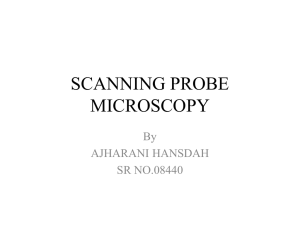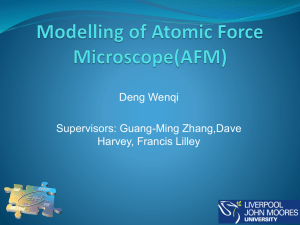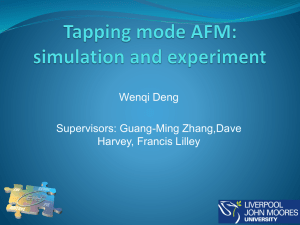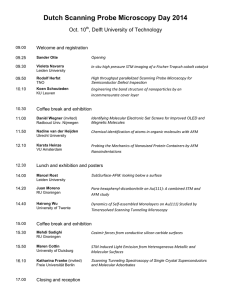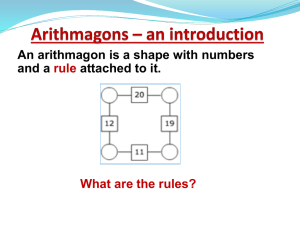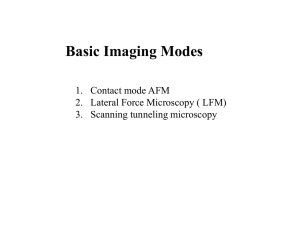Scanning Probe Microscopy: Technology Overview*
advertisement
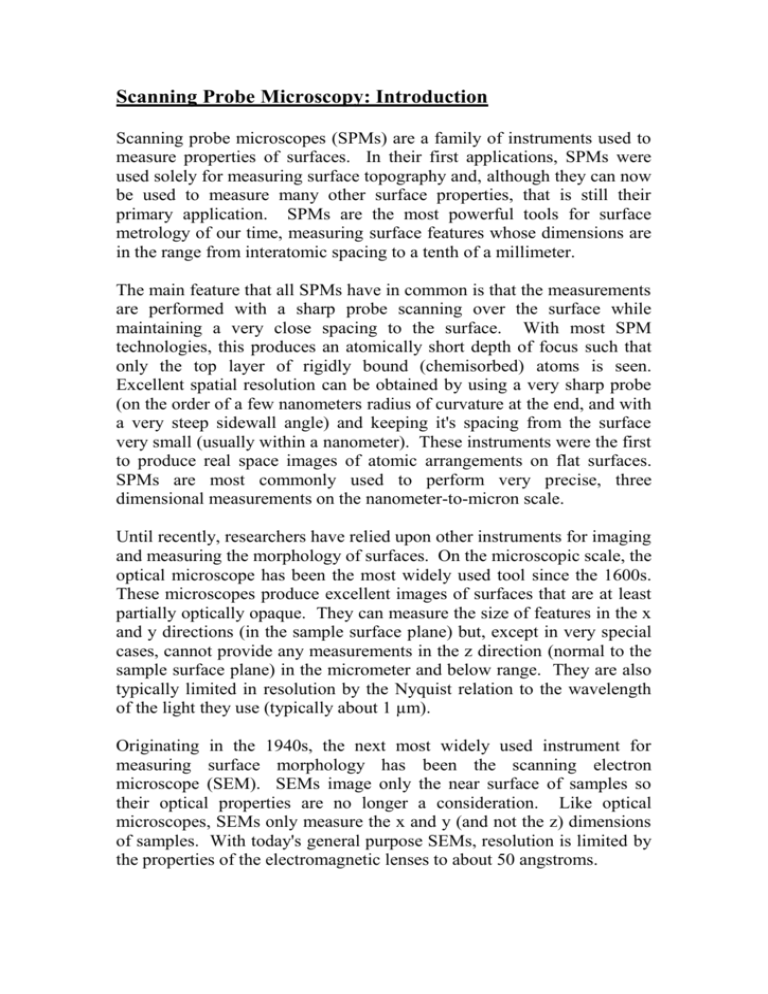
Scanning Probe Microscopy: Introduction Scanning probe microscopes (SPMs) are a family of instruments used to measure properties of surfaces. In their first applications, SPMs were used solely for measuring surface topography and, although they can now be used to measure many other surface properties, that is still their primary application. SPMs are the most powerful tools for surface metrology of our time, measuring surface features whose dimensions are in the range from interatomic spacing to a tenth of a millimeter. The main feature that all SPMs have in common is that the measurements are performed with a sharp probe scanning over the surface while maintaining a very close spacing to the surface. With most SPM technologies, this produces an atomically short depth of focus such that only the top layer of rigidly bound (chemisorbed) atoms is seen. Excellent spatial resolution can be obtained by using a very sharp probe (on the order of a few nanometers radius of curvature at the end, and with a very steep sidewall angle) and keeping it's spacing from the surface very small (usually within a nanometer). These instruments were the first to produce real space images of atomic arrangements on flat surfaces. SPMs are most commonly used to perform very precise, three dimensional measurements on the nanometer-to-micron scale. Until recently, researchers have relied upon other instruments for imaging and measuring the morphology of surfaces. On the microscopic scale, the optical microscope has been the most widely used tool since the 1600s. These microscopes produce excellent images of surfaces that are at least partially optically opaque. They can measure the size of features in the x and y directions (in the sample surface plane) but, except in very special cases, cannot provide any measurements in the z direction (normal to the sample surface plane) in the micrometer and below range. They are also typically limited in resolution by the Nyquist relation to the wavelength of the light they use (typically about 1 µm). Originating in the 1940s, the next most widely used instrument for measuring surface morphology has been the scanning electron microscope (SEM). SEMs image only the near surface of samples so their optical properties are no longer a consideration. Like optical microscopes, SEMs only measure the x and y (and not the z) dimensions of samples. With today's general purpose SEMs, resolution is limited by the properties of the electromagnetic lenses to about 50 angstroms. Scanning probe microscopes are the newest entry into the surface metrology field. As opposed to optical microscopes and SEMs, they do measure surfaces in all three dimensions: x, y, and z. Like SEMs, they image and measure the surface of the sample. X and y resolution in an SPM is typically 20 angstroms and, with the best instruments and the right sample, can be better than 1 angstrom. Z resolution is typically better than 1 angstrom. The table below compares the characteristics of these common technologies for imaging and measuring surfaces. It shows that optical microscopes and SPMs are the quickest and easiest to use, with little or no sample preparation and no vacuum required. Optical microscopes and SEMs have larger fields of view but SPMs provide the highest magnifications and resolution. SEM and SPMs image only the surface and provide larger depth of field, but only SPMs work on nearly all samples with minimal sample preparation. Comparison of Common Techniques for Imaging and Measuring Surface Morphology SEM SPM Operating evironment Optical Microscope ambient, liquid, vacuum vacuum ambient, liquid, vacuum Depth of field small large medium Depth of focus medium small small Resolution: x,y 1.0 µm 5 nm 0.1 - 3.0 nm Resolution: z N/A N/A 0.01 nm Magnification range 1X - 2 x 103X 10X – 106X 5 x 102X - 108X Sample preparation required little freeze drying, coating none Characteristics required of sample must not be completely transparent to light wave no charge buildup on surface must not have excessive variations in surface height Basic SPM Components The basic scanning probe microscope consists of the following components: Scanning System: The most fundamental component of the SPM and the heart of the microscope is the scanner. Depending on the individual design, the scanner may scan the sample if it is small enough or may scan the probe over a large sample. To accomplish the precision required, a piezoelectric tube scanner is typically used and can be controlled to provide sub-angstrom motion increments. Probe: Another key component in the system is the probe, or tip. The probe can be scanned over the sample or it can be stationary and the sample can be scanned under it. With today's sophisticated semiconductor technology, tips and cantilevers are produced in large quantity with consistently shaped, very sharp tips. These tips are secured on the end of cantilevers with a wide range of properties designed for a variety of scanning probe technologies. Cantilevers are available with spring constants less than interatomic bond strengths (about 1 Newton/m) and will therefore allow topographic imaging of surface atomic structure by sliding the tip/cantilever assembly across the surface and monitoring cantilever deflection (contact AFM). These cantilevers can be made with resonant frequencies >10khz to allow rapid scanning over surfaces with high spatial frequency roughness. At the other extreme, the cantilever oscillation techniques (e.g., non-contact AFM, MFM, TappingMode AFM, etc.) require very stiff cantilevers with high resonant frequencies. There are also many types of tips available with varying shapes (for probing different morphologies and scales of surface features) and materials (conducting, magnetized, very hard, etc.). Probe Motion Sensor: This system senses the spacing between the probe and the sample and provides a correction signal to the piezoelectric scanner to keep the spacing constant. For STM, the tunnelling current is used to sense the spacing between the probe and the sample surface. For AFM, the most common design for this function is called an optical lever, or beam deflection system. This design uses a laser shining onto and reflecting off the back of the cantilever and onto a segmented photodiode to measure the probe motion. There are other systems, e.g., interferometers, piezoelectric cantilevers and probe oscillation systems that detect forces by the change in the resonant frequency, phase, or amplitude of oscillation. However, the beam deflection system is the most widely used because it is the lowest noise, most stable and most versatile system available. Electronics: The electronics interface unit provides interfacing between the computer and the scanning system. It supplies the voltages that control the piezoelectric scanner, accepts the signal from the position sensing unit and contains the feedback control system for keeping the spacing between sample and tip constant. Vibration Isolation: The microscope must be isolated from its surroundings vibrations. There are very good, yet simple systems for isolating SPMs from floor vibrations and from acoustic vibration sources. Computer: Finally, scanning probe microscopy would not be feasible without the availability of powerful high-speed computers to drive the system and to process, display, and analyse the image data. Scanning Tunnelling Microscope (STM) The scanning tunnelling microscope was the first SPM and was first recognized as having atomic resolution capability in 1981. It works by mechanically scanning a very sharp conducting tip over the surface of a conducting sample. A bias voltage is applied between the tip and the sample causing a tunnelling current to flow when the tip is kept near the sample. The tunnelling current is of the form: It = Ve-Cd Where: It - the tunnelling current V - the bias voltage C - a constant of the materials d - the nearest spacing between the tip and the sample The strong exponential dependence of the tunnelling current on the tip-tosample spacing makes it possible to use this current in a feedback loop controlling a precision motion device; i.e. a piezoelectric scanner. In response to an applied voltage, the scanner moves the tip over an area of the sample in a raster pattern and the feedback loop causes the tip to track the sample surface with sub-angstrom precision. The coordinates of the tip's path can then be transformed into a map of the surface topography. Example: STM image of oxygen atom lattice on rhodium single crystal (4nm scan) Atomic Force Microscope (AFM) The ability of STM to measure surface morphology is clearly outstanding. Unfortunately, there are some limitations, the most significant of which is that the surface of both the tip and sample must be very good conductors. This severely limits the materials that can be studied and has led to the introduction of the atomic force microscope. Like the STM, the AFM also uses a very sharp tip to probe and map the morphology of a surface. The key element of the AFM is its microscopic force sensor, or cantilever. The cantilever is usually formed by one or more beams of silicon or silicon nitride with a dimension of 100 ~ 500 microns long and 0.5 ~ 5 microns wide. Mounted on the end of the cantilever is a sharp tip used to sense the force between the tip and the sample surface. For normal topographic imaging, the probe tip is brought into continuous or intermittent contact with the sample and raster-scanned over the surface by a piezoelectric scanner that generate the precision motion needed for topographic images and force measurements. Contact AFM In contact AFM, the cantilever deflection represented by the laser spot intensity for quadrants (A+B)-(C+D) is regarded as the vertical force signal between the tip and the sample surface. The cantilever scans over a sample surface and the local height of the sample is measured by recording the vertical motion the tip while keeping the cantilever deflection at constant. Three-dimensional topographical maps of the surface are then constructed by plotting the local sample height versus horizontal probe tip. Lateral Force Microscope (LFM) Since the degree of torsion of the cantilever supporting the probe is a relative measure of surface friction caused by the lateral force exerted on the scanning probe, the laser spot intensity for quadrants (A+C)-(B+D) is regarded as the frictional signal between the probe and the sample surface. This forms another mode called lateral force microscope (LFM). Example: LFM map of a patterned, monolayer, organic film deposited on a gold substrate The strong contrast comes from the different frictional characteristics of the two materials (30 µm scan). Force Curve Measurements In addition to the topographic measurements, the AFM can also record the amount of force felt by the cantilever as the probe tip is brought close to - and even indented into - a sample surface and then pulled away. This technique can be used to measure the long range attractive or repulsive forces between the probe tip and the sample surface, elucidating local chemical and mechanical properties like adhesion and elasticity, and even thickness of adsorbed molecular layers or bond rupture lengths. To help examine the basics of AFM force measurements, the figure above shows a typical force-versus-distance curve or force curve. Force curves typically show the deflection of the free end of the AFM cantilever as the fixed end of the cantilever is brought vertically towards and then away from the sample surface. By applying a triangle-wave voltage pattern to the electrodes for the z-axis scanner, the scanner expands and then contracts in the vertical direction, generating relative motion between the cantilever and sample. The deflection of the free end of the cantilever is measured and plotted at many points as the z-axis scanner extends the cantilever towards the surface and then retracts it again. By controlling the amplitude and frequency of the triangle-wave voltage pattern, one can also vary the distance and speed that the AFM cantilever tip travels during the force measurement. Example: Force curves on patterned regions for different tip and sample functional group terminations Advanced SPM Techniques Since its initial introduction, scanning probe microscopy has already added many more variations to the fundamental scanning tunnelling theme. Once the severe application limit of the STM was overcome by the AFM, the varieties of scanning probe techniques and the range of applications began to mushroom. There are now SPMs commercially available to perform STM, contact AFM, TappingMode AFM, noncontact AFM, lateral force microscopy (LFM), magnetic force microscopy (MFM), electric force microscopy (EFM), phase imaging, nanoindenting/scratching, scanning capacitance microscopy (SCM), and scanning thermal microscopy (SThM). The most significant advances in SPM technology have been the introduction of the TappingMode and LiftMode techniques and the development of technology for operation with large samples in all scanning modes. TappingMode Operation Until the development of TappingMode, the only practical mode of AFM operation was the traditional contact mode. Contact mode successfully performed many pioneering AFM applications and was responsible for the rapid initial growth in interest in AFM. However, it suffers from some drawbacks that preclude it from an even broader area of applications. First, the constant downward force of the tip onto the sample surface is not always low enough to avoid damaging some sample surfaces. These include most biological surfaces, most polymer surfaces, and even many surfaces of seemingly harder materials - a prime example being silicon wafer surfaces. The reason for the lack of force control is that in a typical atmospheric ambient environment, surfaces are always covered by 10 to 30 monolayers of adsorbed gas. The adsorbed gas layer is mostly water vapor, hydrocarbons, nitrogen, and carbon dioxide that is physisorbed onto the surface or held there by the interatomic van der Waals attractive potential. This adsorbed gas layer has associated with it a surface tension that causes the layer to wick up onto the AFM tip when the tip comes into contact with it. This pulls the tip toward the surface with a force that can damage some samples. Another problem that arises with contact AFM is that it is often desirable to examine items that are only loosely bound to a substrate. Examples of this are DNA stretched across a mica surface, particles on a silicon wafer, or particulate samples which are difficult to sufficiently adhere to a substrate. The contact AFM probe pushes these items around on their substrate, either pushing them completely out of the area being analysed or creating streaked, non-physical images. Further more, as the contact AFM tip rubs across the sample, the tip can also cause sufficient frictional force to produce shear forces that can tear surface features. TappingMode imaging overcomes the limitations of the conventional scanning modes by alternately placing the tip in contact with the surface to provide high resolution and then lifting the tip off the surface to avoid dragging the tip across the surface. TappingMode imaging is implemented in ambient air by oscillating the cantilever assembly at or near the cantilever’s resonant frequency using a piezoelectric crystal. The piezo motion causes the cantilever to oscillate with high amplitude (the “free air” amplitude, typically greater than 20nm) when the tip is not in contact with the surface. The oscillating tip is then moved toward the surface until it begins to lightly touch, or “tap” the surface. During scanning, the vertically oscillating tip alternately contacts the surface and lifts off, generally at a frequency of 50,000 to 500,000 cycles per second. TappingMode (amplitude detection): As the oscillating cantilever begins to intermittently contact the surface, the cantilever oscillation is necessarily reduced due to energy loss caused by the tip contacting the surface. The reduction in oscillation amplitude is used to identify and measure surface features. During TappingMode operation, the cantilever oscillation amplitude is maintained constant by a feedback loop. Selection of the optimal oscillation frequency is softwareassisted and the force on the sample is automatically set and maintained at the lowest possible level. When the tip passes over a bump in the surface, the cantilever has less room to oscillate and the amplitude of oscillation decreases. Conversely, when the tip passes over a depression, the cantilever has more room to oscillate and the amplitude increases (approaching the maximum free air amplitude). The oscillation amplitude of the tip is measured by the detector and input to the controller electronics. The digital feedback loop then adjusts the tipsample separation to maintain a constant amplitude and force on the sample. TappingMode inherently prevents the tip from sticking to the surface and causing damage during scanning. Unlike contact mode, when the tip contacts the surface, it has sufficient oscillation amplitude to overcome the tip-sample adhesion forces. Also, the surface material is not pulled sideways by shear forces since the applied force is always vertical. TappingMode (phase detection or phase imaging): Phase Imaging is a powerful extension of TappingMode Atomic Force Microscopy (AFM) that provides nanometer-scale information about surface structure often not revealed by other SPM techniques. By mapping the phase of the cantilever oscillation during the TappingMode scan, phase imaging goes beyond simple topographical mapping to detect variations in composition, adhesion, friction, viscoelasticity, and perhaps other properties. In TappingMode AFM, the cantilever is excited into resonance oscillation with a piezoelectric driver. The oscillation amplitude is used as a feedback signal to measure topographic variations of the sample. In phase imaging, the phase lag of the cantilever oscillation, relative to the signal sent to the cantilever's piezo driver, is simultaneously monitored and recorded. The phase lag is very sensitive to variations in material properties such as adhesion and viscoelasticity. Once the SPM is engaged in TappingMode, phase imaging is enabled simply by displaying a second image and selecting the phase data type in software. Both the TappingMode topography and phase images are viewed side-by-side in real time. The resolution of phase imaging is comparable to the full resolution of TappingMode AFM. Phase imaging can also act as a real-time contrast enhancement technique. Because phase imaging highlights edges and is not affected by large-scale height differences, it provides for clearer observation of fine features, such as grain edges, which can be obscured by rough topography. Applications of phase imaging include identification of contaminants, mapping of different components in composite materials, and differentiating regions of high and low surface adhesion or hardness. In many cases, phase imaging complements lateral force microscopy (LFM) and force modulation techniques and provides additional information more rapidly and with higher resolution. Example: TappingMode and phase images of a composite polymer embedded in a uniform matrix. The high resolution of the phase contrast image highlights the twocomponent structure of the composite regions. LiftMode Operation Development of LiftMode AFM operation has brought the measurement of magnetic and electric fields associated with surfaces into the practical and useful realm. Measuring these fields in the vicinity of surfaces has been an ongoing effort for the last seven years by SPM researchers. These measurements require a probe that is sensitive to the field and also tracks the topography so that the field measuring probe is not varying its spacing from the surface. This is often quite difficult since, for example, the surfaces of magnetic data storage media are topographically quite rough. Using the same probe to simultaneously track topography and the electric or magnetic force results in a large topographic signal being superimposed on the electric or magnetic field map. It is very desirable to separate these two kinds of information. This problem led to the development of LiftMode. LiftMode is two-pass technique for measurement of magnetic and electric forces above sample surfaces. On the first pass over each scan, the sample's surface topography is measured and recorded. On the second pass, the tip is lifted a user-selected distance above the recorded surface topography and the force measurement is made. In LiftMode, the tip makes a first pass across the sample surface using TappingMode to measure the topography of that line. It then raises up an operator-selected amount and retraces the surface topography while performing non-contact measurement of the electric or magnetic field near the surface. It then repeats these measurements over the entire area of interest. In this way, in one scan of the area, the system acquires a topographic map of the surface and a field map of the same area. These are displayed separately and in real time during the measurement and, upon completion of the area scan, can be stored and analysed independently. Magnetic Force Microscope (MFM) Magnetic force microscopy (MFM) is developed using LiftMode operation. It brings the power of SPM to a convenient and cost-effective imaging tool that is ideal for many data storage device applications. By scanning a tiny ferromagnetic probe over a sample, MFM maps the stray magnetic fields close to the sample surface. To understand the principles of MFM, we must first look at SPM, from which the technique is derived. An SPM probe consists of a sharp tip mounted on a weak cantilever spring. The tip is brought close to the sample and a piezoelectric scanner moves the probe in a raster pattern. Interactions between the tip and sample deflect the cantilever. Feedback continually adjusts the z (vertical) position of the sample to keep the cantilever deflection at a constant value while scanning. The resulting vertical offset z (x, y) is displayed as a three-dimensional image of the surface topography (as in the left frame for the hard-disk shown to the left). For MFM, batch-microfabricated silicon probes are coated with a ferromagnetic material. The tip is scanned several tens or hundreds of nanometers above the sample, avoiding contact. Magnetic field gradients exert a force on the tip's magnetic moment, and monitoring the tip/cantilever response gives a magnetic force image. To enhance sensitivity, most MFM instruments oscillate the cantilever near its resonant frequency (around 100 kHz) with a piezoelectric element. Gradients in the magnetic forces on the tip shift the resonant frequency of the cantilever. Monitoring this shift, or related changes in oscillation amplitude or phase, produces a magnetic force image With LiftMode, separation of topographic and magnetic information was made possible. In this new technique, each line in the raster scan pattern is passed over twice. On the first pass, topographical information is recorded using TappingMode (in which the oscillating cantilever lightly taps the surface). An image of the topography is obtained by using the oscillation amplitude as a feedback signal for the tip-sample spacing. Magnetic force data is acquired during a second pass, for which the tip is raised to a user-selected "lift height." The lift height (typically 20-200 nm) is added point-by-point to the stored topographical data, thus keeping the tip-sample separation constant and preventing the tip from interacting with the surface. These two-pass measurements are taken for every scan line to produce separate topographic and magnetic force images of the same area. Example: MFM images of overwritten tracks on a textured hard disk The topography (left) was imaged using TappingMode; the magnetic force image of the same area (right) was captured with LiftMode (lift height 35 nm) by mapping shifts in cantilever resonant frequency. Track width and skew, transition irregularities, and the difference between erased and virgin areas are visible (25 µm scan). Force Modulation Force modulation imaging is a technique that identifies and maps differences in surface stiffness or elasticity. It is one of several techniques developed as extensions to the basic SPM topographical mapping capabilities. These techniques use a variety of surface properties to better differentiate among materials where topographical differences are small or unmeasurable. With the force modulation technique, the probe or sample assembly is scanned with a small vertical (z) modulation significantly faster than the scan rate. The force on the sample is modulated about the setpoint scanning force such that the average force on the sample is equivalent to that in simple contact mode. When the probe is brought into contact with a sample, the surface resists the oscillation and the cantilever bends. Under the same applied force, a stiff area on the sample will deform less than a soft area; i.e., stiffer surfaces cause greater resistance to the vertical oscillation and, consequently, greater bending of the cantilever. The variation in cantilever deflection amplitude is a measure of the relative stiffness of the surface. Topographical information (DC, or non-oscillatory deflection) is collected simultaneously with the force modulation data (AC, or oscillatory deflection). Force modulation imaging can be used in a wide range of applications including identifying transitions between different components in composites, rubber and polymer blends, evaluating polymer homogeneity, imaging organic materials on hard substrates, detecting residual photoresist on integrated circuits, and identifying contaminants in a variety of materials. Nanoindentation Using a diamond tip mounted to a metal-foil cantilever, you can indent a surface and immediately image the indentation. This in situ imaging ability eliminates the need to move the sample, switch tips, relocate the area for scanning, or use an entirely different instrument to image the indentation. Although indentation cantilevers have higher spring constants than typical imaging cantilevers, it is still possible to image soft samples with relatively low forces. This is possible using TappingMode which requires less force to image a sample than contact mode operation. The diamond tips are sufficiently sharp to provide good image resolution. The nanoindentation capability also includes the ability to perform scratch and wear tests using the same cantilevers. A major application of nanoindentation is the measurement of mechanical properties of thin films, such as diamond-like carbon, using indentation to investigate hardness, and scratch or wear testing to investigate film adhesion and durability. Recent studies have been done on chemical mechanical polishing samples (CMP, used in the semiconductor industry), polymers, such as polyimide films, and biological samples such as bovine and human sperm nuclei. Example: Indentations on two different polymers using the same forces to compare hardness. Each sample was indented four times using each of four forces. The sample on the left is a PMDA-ODA polyimide, and the sample on the right is a BPDA-PDA polyimide. The indentation depths vary from about 20-200nm and are deeper for the softer PMDA-ODA polyimide (3µm scan). Barriers The most important characteristic of an SPM is its ability to very accurately measure surface topography. In all of its modes of operation, it is either measuring topography or using topography to track the surface in the measurement of another parameter (magnetic field, electric field, etc.). This need for high accuracy in measuring surface topography has produced conflicting demands on scanning force microscopy. The dichotomy derives from the requirement that the tip move across the surface very rapidly while following the surface topography very closely (i.e., the tip is tightly coupled to the surface through the feedback loop). This requires, in some cases, forces on the surface are in excess of the yield force or binding force of a feature on the surface. The unfortunate result is that surface features of interest can be modified by the scanning probe. The close coupling has also made it difficult to separate topographic information from other parameters being measured by SPMs. For example, in magnetic force microscopy, a common problem has been that surface topography contaminates the magnetic force images. This results from the fact that the tip is trying to follow the topography and, at the same time, measure the magnetic force associated with the surface. Hysteresis and aging of the piezoelectric scanners and artifacts created due to the shape of SPM probes also remain as some of the key issues in SPM applications. Summary Development of scanning probe microscopes has allowed scientists and engineers to see structure and detail with unprecedented resolution and without the need for rigorous sample preparation. Scanning tunnelling microscopy produced dramatic images of atomic lattices and atomic force microscopy broadened the technology to non-conductive surfaces. TappingMode now permits imaging of soft materials without damage to the sample and LiftMode allows separate imaging of topography and other parameters, such as magnetic of electric force, without crosscontamination. In the few short years of its existence, these and other innovations have taken SPM from laboratory curiosity to one of the most powerful, flexible, and easy to use techniques for surface characterization. The SPM techniques are being applied to a wide array of application areas, from biology to semiconductors, from data storage media to polymers, and from integrated optics to measurement of forces between particles and surfaces. These applications are carried out in a variety of environments. SPMs can be operated in ambient air, in vacuum, and in liquids. Biological measurements, in particular, are often carried out in vivo in biological fluids. Electrochemical experiments are performed in liquid cells, allowing atomic scale observation of the electrochemical processes. Film deposition, nucleation and growth are studied in the vacuum environment of the deposition system. In some cases, surface cleaning studies are done at atmospheric pressure but in the controlled environment of a dry glove box. The range and scope of SPM applications continues to grow at a rapid pace. Various Techniques for Scanning Probe Microsocopy: Scanning Tunnelling Microscopy (STM): Measures topography of surface electronic states using the tunnelling current which is dependent on the separation between the probe tip and a highly conductive sample surface. Contact Mode AFM: Measures topography by sliding the probe tip across sample surface. Lateral Force Microscopy (LFM): Measures frictional forces between the probe tip and the sample surface. Force Modulation: Measures relative stiffness of surface features. TappingMode AFM: Measures topography by tapping the surface with an oscillating probe tip; eliminates shear forces which can damage soft samples and reduce image resolution. Phase Imaging: Measures variations in surface properties (stiffness, adhesion, etc.) as the phase lag of the cantilever oscillation relative to the piezo drive. Non-contact Mode AFM: Measures topography by sensing Van der Waals attractive forces between surface and probe tip held above surface; provides lower resolution than either contact mode or TappingMode. LiftMode: A combined two-pass technique that separately measures topography using TappingMode and another selected property (magnetic force, electric force, etc.) using topographical information to track the probe tip at a constant distance above the surface; provides the best resolution and eliminates cross-contamination of images. Magnetic Force Microscopy (MFM): Measures magnetic force gradient and distribution above the sample surface using amplitude, phase or frequency shifts; best performed using LiftMode to track topography. Electric Force Microscopy (EFM) Measures electric field gradient and distribution above the sample surface, best performed using LiftMode to track topography. Scanning Thermal Microscopy (SThM): Measures temperature distributions on the sample surface. Scanning Capacitance Microscopy (SCM): Measures carrier (dopant) concentration profiles on semiconductor surfaces. Nanoindentation: For indenting and scratching thin films and other surfaces. Lithography: Use of probe tip to write patterns in either STM or AFM contact mode.
